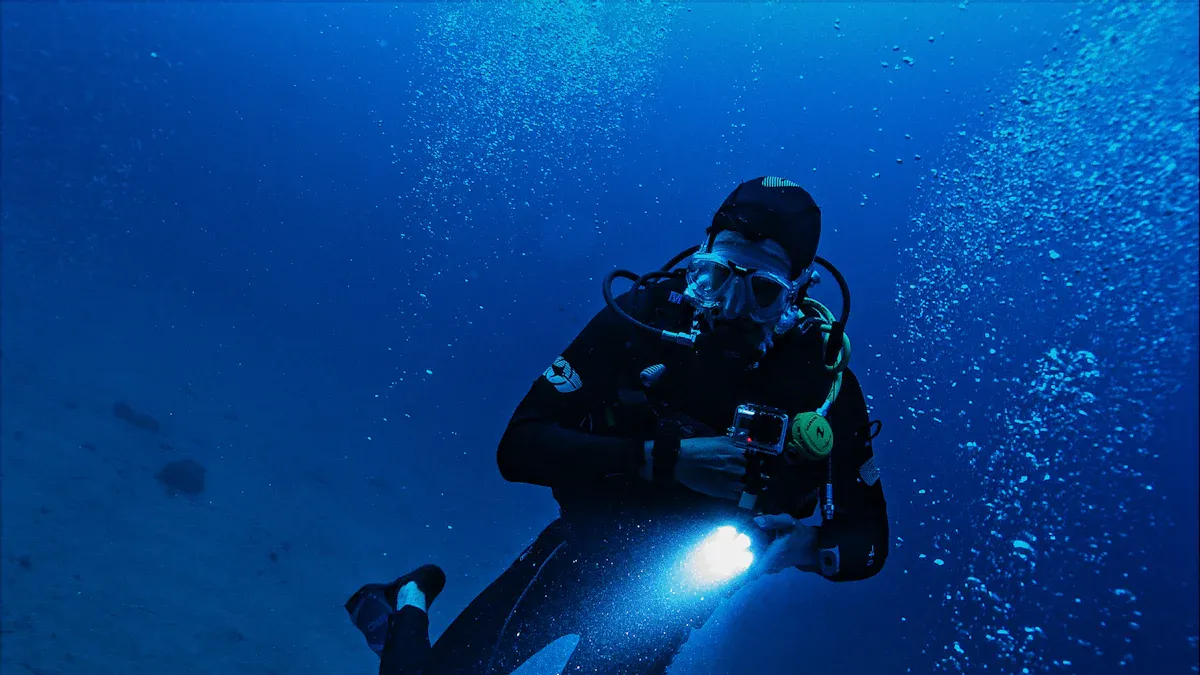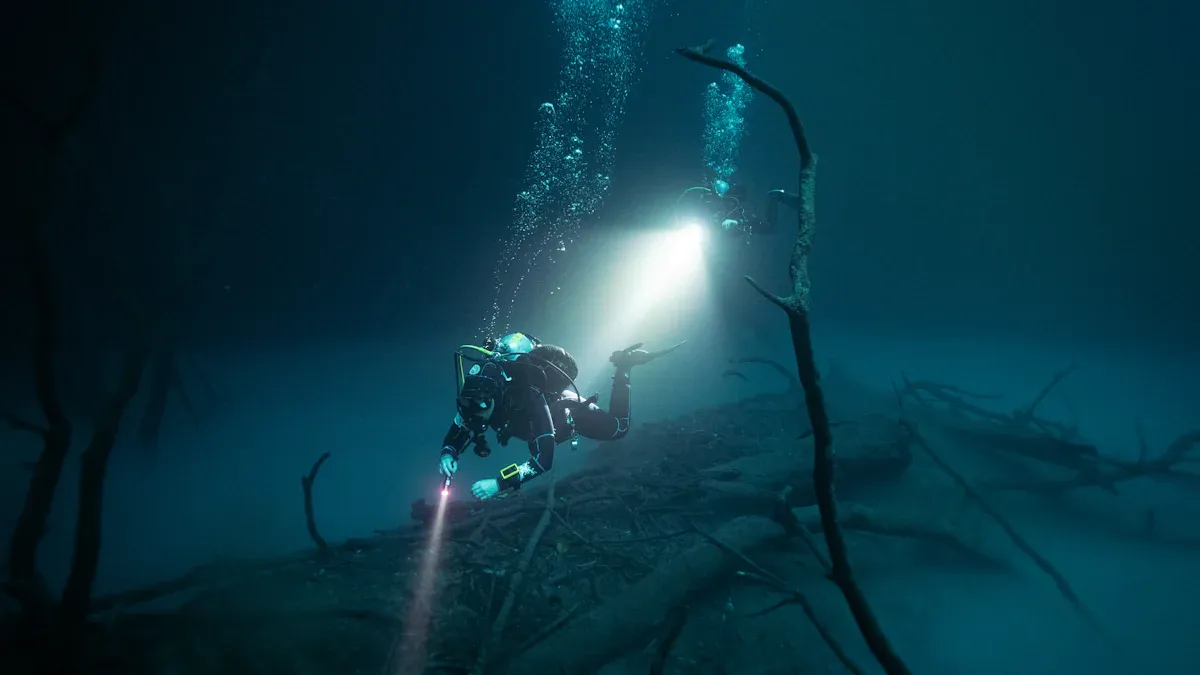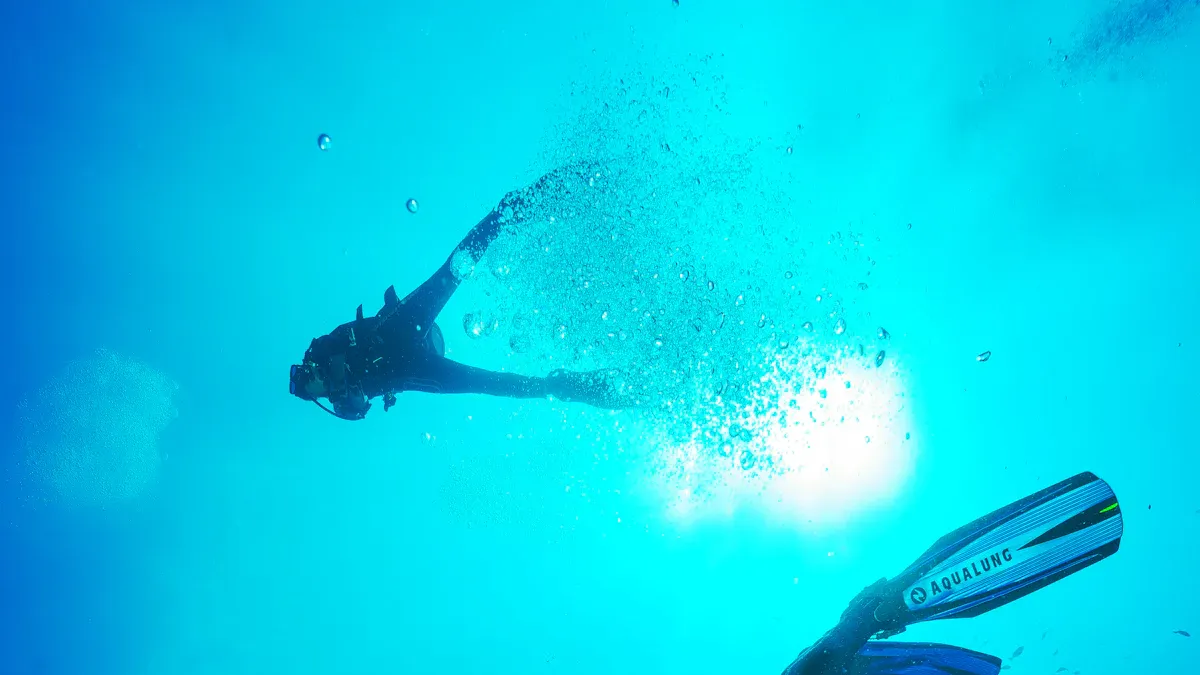How Flashlights are Used in Underwater Exploration and Diving

Underwater environments often challenge your visibility. A diving flashlight becomes your essential tool, cutting through murky waters and revealing hidden wonders. Diving flashlights not only illuminate your path but also enhance safety by helping you communicate with others. Whether exploring wrecks or observing marine life, flashlights ensure you never miss a moment.
Key Takeaways
Diving flashlights help you see better in dark water. They let divers move safely and enjoy sea creatures.
Divers use light signals to talk underwater. Specific movements send messages to friends.
Pick a dive light that fits your needs. Main lights are for regular use, and backups keep you safe in emergencies.
Practical Uses of Diving Flashlights

Enhancing Visibility in Low-Light and Murky Conditions
Underwater environments often lack sufficient natural light, especially at greater depths or in murky waters. Diving flashlights provide essential illumination in dark underwater environments, allowing you to navigate confidently and avoid potential hazards. Their advanced optics and specialized reflectors optimize beam distance, enabling you to see objects clearly even in challenging conditions. Whether you are exploring coral reefs or wreck diving, these tools ensure you can fully appreciate the underwater ecosystem. Flashlights also help you maintain visual contact with your diving buddies, enhancing safety throughout your dive.
Signaling and Communication During Dives
Effective communication is vital during any dive, and flashlights play a key role in this. Light signals work exceptionally well in low-visibility conditions, such as night or cave diving. For example:
A circular motion with your torch indicates "OK" and confirms everything is fine.
Waving the torch up and down slowly grabs attention without urgency.
Rapid side-to-side movements signal an emergency.
Pre-agreed signals, like three quick flashes, can communicate specific messages to surface teams.
Using these techniques, you can coordinate with your group, signal for help, or alert others to potential issues. Dive lights ensure your messages are clear, even in the most challenging underwater scenarios.
Illuminating Caverns, Wrecks, and Marine Life
Exploring caverns and wrecks presents unique challenges, such as poor visibility from silt, entanglement hazards, and navigation difficulties. Diving flashlights help you overcome these obstacles by providing a focused beam that penetrates through water effectively. This illumination allows you to spot marine life, coral formations, and historical artifacts hidden in the shadows. Dive lights also enhance your ability to identify potential hazards, ensuring a safer and more enjoyable experience. Whether you are observing vibrant marine creatures or navigating confined spaces, diving LED torches are indispensable tools for underwater exploration.
Types of Dive Lights and Their Features

Primary Diving Flashlights vs. Backup Dive Lights
When selecting dive lights, you should understand the differences between primary and backup options. Primary lights are your main source of illumination during a dive. They are longer, brighter, and designed for extended use. Backup dive lights, on the other hand, are smaller and serve as a safety measure in case your primary light fails. Here's a quick comparison:
Feature | Primary Dive Lights | Backup Dive Lights |
|---|---|---|
Length | Longer in length | Smaller and lighter in weight |
Battery Life | Longer battery life for extended dive times | Non-rechargeable |
Power | Higher power and brightness for deeper dives | Provides reasonable light, dimmer than primary |
Usage | Used for the entire duration of the dive | Serves as a backup if primary fails |
Cost | Generally more expensive | Typically cheaper |
Choosing the right combination ensures you stay prepared for any situation underwater.
Waterproofing, Depth Ratings, and Durability
Diving flashlights must withstand the harsh underwater environment. Look for models with high waterproof ratings, such as IPX8, which indicates the flashlight can be submerged beyond one meter for extended periods without damage. These torches often feature reinforced casings and impact-resistant designs to handle saltwater exposure and accidental drops. This durability ensures reliability during challenging dives, whether you're exploring coral reefs or wreck diving.
Tip: Always check the depth rating of your flashlight to ensure it matches your diving needs.
Beam Strength, Lumens, and Adjustable Settings
Beam strength and lumens significantly impact underwater visibility. Higher lumens provide better light and range, but suspended particles in the water can cause backscatter, reducing clarity. Dive lights with adjustable brightness levels allow you to adapt to varying conditions. For example:
Use lower settings to conserve battery power when maximum brightness isn't necessary.
Switch to a narrow beam for focused illumination in darker areas.
A recommended lumen range for diving is between 200 and 500, offering optimal visibility without overwhelming your surroundings. Adjustable settings enhance usability, making your diving flashlight versatile for different underwater scenarios.
Best Practices for Using Diving Flashlights
Securing Dive Lights with Lanyards or Handles
Losing your flashlight during a dive can compromise your safety in challenging conditions. To prevent this, secure your dive lights using reliable methods:
Attach wrist lanyards for convenience, though some divers may find them restrictive.
Use stainless bolt snaps for durability and reliability. Secure them with a piece of #24 braided nylon line for added strength.
Stow backup lights properly to avoid dangling. Bungee cords or bicycle inner tubes work well for this purpose.
Consider extendable lanyards attached to D-rings for flexibility and ease of access.
These techniques ensure your torches remain accessible and secure throughout your underwater exploration.
Positioning for Maximum Illumination
Proper positioning of your diving flashlight enhances visibility and reduces distractions. Follow these tips to maximize illumination:
Choose a bright light with a wide beam angle for broader coverage during nighttime dives.
Adjust the light's power based on water clarity. Murky conditions require higher intensity.
Experiment with angles to highlight textures and minimize shadows.
Angle your light slightly away from your lens to reduce backscatter caused by suspended particles.
Use narrow beams for focused illumination or wide beams for observing larger areas.
Marking your exit point with a reliable light source also ensures a safe return, especially in low-visibility environments.
Maintenance and Storage Tips for Longevity
Proper care extends the lifespan of your diving LED torches. After each dive, rinse your flashlight with fresh water to remove salt and debris. Pay special attention to the O-ring:
Clean it with warm water and a soft toothbrush to maintain its integrity.
Lubricate it with silicone grease to ensure a proper seal.
Check for twists or misalignment before reassembling.
Avoid drying your flashlight with towels, as lint can interfere with sealing. Instead, let it air dry completely before storage. Store your torches in a cool, dry place to prevent damage and ensure they are ready for your next underwater adventure.
Choosing Dive Lights for Different Scenarios
Recreational Diving: Simplicity and Versatility
For recreational diving, you should prioritize dive lights that are simple to use and versatile. These flashlights should meet the demands of various underwater conditions. Key features to consider include:
Intended Use: Match the flashlight to your diving environment, such as shallow reefs or wreck diving.
Lumens: Opt for higher lumens to ensure bright light output for better visibility.
Beam Angle: A wider beam works well for general area lighting, while a narrow beam is ideal for focused tasks.
Water Resistance: Ensure the flashlight is waterproof to handle underwater exploration.
Durability: Choose a robust design to withstand the rigors of diving.
Special Features: Adjustable beam angles and compatibility with dive heaters can enhance functionality.
These features ensure your flashlight performs reliably during recreational dives, offering both safety and convenience.
Technical Diving: Redundancy and Advanced Features
Technical diving demands advanced dive lights with specialized features. These flashlights must provide intense illumination and cater to specific underwater challenges. For example, larger flashlights with extended battery life are essential for longer dives. Specialized beam patterns improve light dispersion and clarity, which is crucial for navigating caves or wreck diving.
Feature | Description |
|---|---|
Brightness | High-intensity illumination for deep dives. |
Beam Angle | Narrow beams for confined spaces; wide beams for open water. |
Battery Life | Extended runtime to support prolonged dives. |
Compatibility | Designed to work with dive heaters for added functionality. |
Carrying backup lights is also critical. These smaller torches act as a safety measure in case your primary light fails, ensuring redundancy during complex dives.
Night Diving and Specialty Dives: Unique Lighting Needs
Night diving introduces unique challenges due to reduced visibility. You should carry at least two dive lights: a dependable primary light for navigation and a backup light for emergencies. A primary light with strong lumen output and extensive burn time ensures you can explore confidently.
Tip: Use a small light with average intensity to avoid startling nocturnal marine life.
Beam type also matters. Narrow beams focus light on specific areas, while wide beams illuminate larger spaces. Rechargeable torches are environmentally friendly and cost-effective for frequent divers. These considerations make diving LED torches indispensable for night diving and other specialty dives, such as wreck diving or underwater photography.
Diving flashlights play a vital role in ensuring your safety and enhancing visibility underwater. Selecting the right flashlight tailored to your diving needs is crucial. Always carry backups to prepare for unexpected situations.
Pro Tip: Regularly maintain your dive lights and practice using them. This ensures reliability and a seamless underwater experience.
FAQ
What is the ideal lumen range for diving flashlights?
A lumen range of 200–500 works best for most dives. It provides sufficient brightness without causing backscatter in murky water.
How do you prevent backscatter when using a dive light?
Angle your flashlight slightly away from your line of sight. This reduces light reflection from suspended particles and improves visibility.
Can you use regular flashlights for diving?
No, regular flashlights lack waterproofing and depth ratings. Always use dive-specific flashlights designed for underwater conditions.
See Also
How Diving Flashlights Differ From Regular Flashlights
Exploring UV Flashlights: Their Uses And Advantages
Various UV Flashlight Types Utilized In Forensic Science
